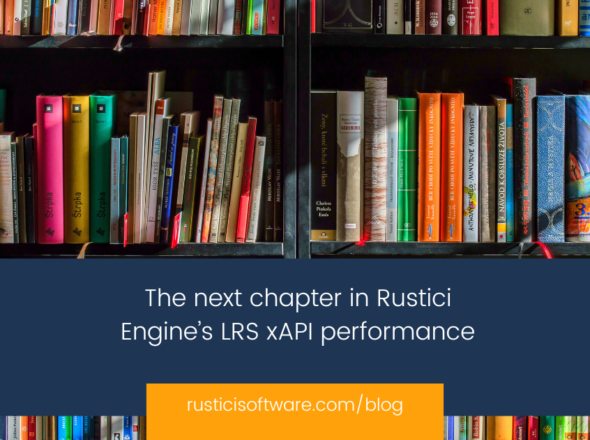One of my favorite things about working at Rustici? There are a lot, but one has to be hanging out and chatting with other eLearning standards nerds. So whenever I have the chance to present to the xAPI Cohort, I jump at it. You’re my people! Recently, I had the opportunity to share my years of procurement knowledge and lessons learned with the latest cohort (cohortions? cohortians?). We had a room full of folks who wanted to learn more about best practices for procuring xAPI and cmi5 technologies, and we thought we’d share those with you.
It’s important to remember that once you find your dream tool, the challenge of procuring it begins. While making sure you receive all the features and functionality you want out of a product is key, it’s also important to help the others on your team get what they need to help you. In my 13 years of experience at Rustici, I’ve picked up a few tips and tricks to help eLearning professionals more easily navigate procurement. Here are my top 5 tips for procuring xAPI technologies to ensure conformance and future-proof your tech stack.
Conversations to have in your organization
Different teams and roles will be impacted in different ways. Identify who will be impacted by this effort, including your learners, administrators, content authors, decision makers, executives and more.
The average organization has more than 25 different learning technologies in their ecosystem! With that many, you might already have a system that supports xAPI and cmi5. Take the time to inventory your existing relevant technologies to see if they are compatible or incompatible with your chosen standards.
What does your team plan to do with all the xAPI data? What about other teams? Do you need to share the data with other systems like a BI tool? Coming up with a plan for what data you want, what to do with it and how to display the results will help you determine which platforms fit your needs. Knowing your xAPI end in mind will help your internal teams work together to meet that outcome.
Finally, decide what tools you will need. Your content player vendor must have an LRS to be conformant. Does your authoring tool publish in xAPI and cmi5? Do you have a preferred analytics tool or will you need one? These are all points you want to take into consideration when moving platform vendors.
When to start talking about xAPI and cmi5 with your vendors
You’ve weighed the pros and cons of various tools and decided that xAPI’s advanced data tracking capabilities will be an asset to your learning and development program. That’s great! But when do you start getting serious and what are the next steps?
The time is now. Start by having conversations with your current platform and technology vendors. Let them know your organization plans to implement xAPI and cmi5, what those plans are and what types of support you’ll need. Then find out if the support you require is on their roadmap.
Remember to keep the “end in mind” with xAPI. What do you want to do with xAPI and cmi5 data, exactly? Which report do you want to see? What tools are you using to integrate xAPI together? Being able to tell a vendor precisely what you’re intending to do with xAPI data can help them with quotes and project plans.
Here are a few other natural times to talk to current vendors about your intent:
- During product renewals.
- Contract conclusions.
- Once you’ve decided to move forward.
Right now xAPI is in a bit of a chicken and egg situation. Generally, vendors aren’t supporting it because customers aren’t asking for the type of xAPI support they need. Customers aren’t leveraging xAPI and cmi5 because their technology vendors don’t support it. Until the demand from you increases, vendors won’t add support. If your vendor is a Rustici Software customer, encourage them to contact us to see how they can add support for different learning standards into their platform. Knowing your xAPI end in mind will help drive actionable steps towards getting the right tools in your hands.
What to ask your current and potential vendors
Once you have a plan in place for your future goals and have inventoried your existing systems, it’s time to reevaluate your current platform vendors and further look into ones that might be a good fit.
Here are a few questions to ask current and potential vendors:
- What are your tools and platforms capable of? If you have specific goals, ask if they can meet them.
- Are the tools conformant with your chosen standards? Don’t get discouraged if xAPI and cmi5 aren’t currently supported by the vendor, but they should be on the vendor’s product roadmap.
- Can the data be exported or shared in a non-proprietary way? xAPI is about collecting and sharing data. Make sure you have ways to access it outside the platform.
- Have you tested your platform in a conformance test suite? If they have, they should be able to provide documentation.
- How exactly will the vendor help drive your project towards the xAPI goal in mind?
Passing the test
Test suites are available to validate xAPI and cmi5 conformance, and the platform or system you choose should be tested in a test suite. Similarly as a content creator, you should run your content through a test suite.
Available xAPI and cmi5 test suites hosted by ADL:
- Learning Record Store (LRS) Test Suite: Tests to see if the LRS is conformant to the standard. Vendors will receive a conformance certificate.
- cmi5 LMS Test Suite (LTS): Vendors can test that their LMS is conformant to the cmi5 specification. Ask your vendor to provide the JUnit XML file.
- cmi5 Content Conformance Test Suite (CTS): For content creators publishing as cmi5. The CTS provides test reports to prove conformance to specification.
Other handy tools:
If your LMS doesn’t have or won’t provide you with conformance documentation, Torrance Learning has released a tool for seeing how well your LMS handles xAPI and cmi5 content. Simply download their course packages and upload them into your LMS. And don’t forget you can always use SCORM Cloud to preview your content and view debug logs for any errors.
Being ready for the future
If you’re thinking this is a lot of work to complete before the end of the budget season or the year, no need to stress! There is plenty of time to create a solid plan for moving forward with xAPI and cmi5 and planning steps for systems procurement. Take your time considering what you want to eventually accomplish and discover what tools are available to help to future-proof your tech stack.
I’ve had several occasions working with clients where they admit that they know nothing about their organization’s approval process and have never actually worked with procurement before. In these moments, we often share a few strategies to help prepare the team for next steps with their own procurement team. If you need help with procuring the right tool or choosing the right eLearning standard, ask us! We’re happy to help.


